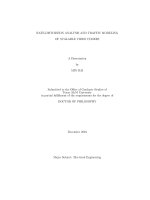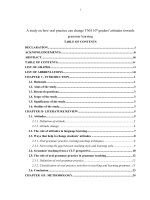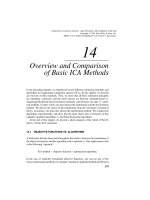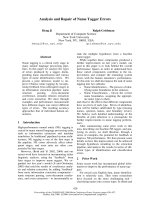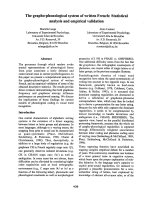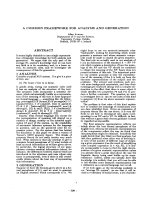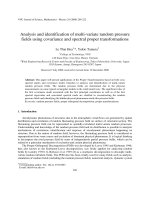Biological network analysis and comparison
Bạn đang xem bản rút gọn của tài liệu. Xem và tải ngay bản đầy đủ của tài liệu tại đây (16.29 MB, 186 trang )
BIOLOGICAL NETWORK ANALYSIS AND
COMPARISON
TIAN DECHAO
(MASTER OF SCIENCE, NORTHEAST NORMAL UNIVERSITY, CHINA)
A THESIS SUBMITTED
FOR THE DEGREE OF DOCTOR OF
PHILOSOPHY
DEPARTMENT OF STATISTICS AND APPLIED
PROBABILITY
NATIONAL UNIVERSITY OF SINGAPORE
2014
DECLARATION
I hereby declare that the thesis is my original
work and it has been written by me in its entirety.
I have duly acknowledged all the sources of
information which have been used in the thesis.
This thesis has also not been submitted for any
degree in any university previously.
Tian Dechao
5
th
February, 2015
ii
Thesis Supervisor
Choi Kwok Pui Associate Professor, Department of Statistics and Ap-
plied Probability, National University of Singapore, Singapore, 117546
iii
Papers and Manuscripts
Papers
Tian, D., and Choi, K. P. (2013). Sharp Bounds and Normalization of
Wiener-Type Indices. PLoS ONE, 8(11), e78448.
Zhang, S.
∗
, Tian, D.
∗
, Tran, N. H., Choi, K. P., and Zhang, L.X (2014).
Profiling the Transcription Factor Regulatory Networks of Human Cell
Types. Nucleic Acids Research, 42(20), 12380–12387.
Manuscript
Tian, D., Choi, K. P., and Zhang, L.X. Profiling Human Embryonic
Stem Cell via Feed-Forward Loops in Transcription Factor Regulatory
Network.
* co-first authorship
iv
Acknowledgements
I would like first to express my gratitude and appreciation to my supervisor,
Prof. Choi Kwok Pui for his complete trust, endless patience, and expert
guidance in my research. He helps me to build up my confidence in further
pursuit of my academic dream and provides detailed recommendations for
my future plan. He also takes care of my daily life and always hope the
best for me.
I would like to show my gratitude for Prof. Zhang Louxin. His style of
thinking, analyzing, and writing help me a lot in research. My thanks also
goes to the other Network Biology group members for helpful discussion
and warm friendship.
I want to take this opportunity to thank Prof. Bai Zhidong for his
support in my PhD application, encouragement in my research and care for
my daily life. I would like to express special thanks to other faculty members
and support staff. I am grateful to National University of Singapore for
awarding me the Graduate Research Scholarship to pursue research in my
area of interest.
I would also like to express my sincere thanks to my friends Dr. Li
Xiang and Dr. Huang Zhipeng for their friendship and encouragement in
the journey. I would like to thank seniors Dr. Hu Jiang, Dr. Li Hua and Dr.
Xia Ningning for their generous guidance and kind help in many aspects.
v
Acknowledgements
Also I would like to thank other PhD students in Department of Statistics
and Applied Probability who helped me in one way or another. All my
friends whom I have forgotten to mention here are also greatly appreciated
for their assistance and encouragement.
Finally, I am grateful to my family for their unconditional support and
encouragement.
vi
Contents
Declaration ii
Thesis Supervisor iii
Papers iv
Acknowledgements v
Summary xi
List of Tables xiii
List of Figures xvi
1 Introduction 1
1.1 Complex biological networks . . . . . . . . . . . . . . . . . . 1
1.2 High-throughput technologies to map networks . . . . . . . . 2
1.2.1 High-throughput technologies . . . . . . . . . . . . . 2
1.2.2 Errors in the observed biological networks . . . . . . 6
1.2.3 Network resources and databases . . . . . . . . . . . 6
1.3 Mathematical formulation . . . . . . . . . . . . . . . . . . . 8
1.3.1 Mathematical representation . . . . . . . . . . . . . . 8
1.3.2 Definitions and notations . . . . . . . . . . . . . . . . 8
1.3.3 Biological network analysis and comparison . . . . . 9
1.3.4 Network analysis and comparison toolsets . . . . . . 21
1.4 Thesis organization . . . . . . . . . . . . . . . . . . . . . . . 21
2 Sharp Bounds and Normalization of Wiener-type Indices 23
vii
Contents
2.1 Introduction . . . . . . . . . . . . . . . . . . . . . . . . . . . 23
2.2 Methods . . . . . . . . . . . . . . . . . . . . . . . . . . . . . 26
2.2.1 Definitions and terminologies . . . . . . . . . . . . . 26
2.2.2 Effect of number of nodes on Wiener type indices . . 29
2.2.3 Main idea . . . . . . . . . . . . . . . . . . . . . . . . 30
2.3 Results . . . . . . . . . . . . . . . . . . . . . . . . . . . . . . 30
2.4 Related work . . . . . . . . . . . . . . . . . . . . . . . . . . 32
2.4.1 Important special cases . . . . . . . . . . . . . . . . . 32
2.5 Applications . . . . . . . . . . . . . . . . . . . . . . . . . . . 33
2.6 Experiments . . . . . . . . . . . . . . . . . . . . . . . . . . . 34
2.6.1 Experiment 1: Hierarchical clustering of random net-
works . . . . . . . . . . . . . . . . . . . . . . . . . . 36
2.6.2 Experiment 2: Hierarchical clustering of trees . . . . 37
2.6.3 Experiment 3: Hierarchical clustering of random net-
works and trees . . . . . . . . . . . . . . . . . . . . . 38
2.6.4 Details on generating random networks . . . . . . . . 39
2.7 Conclusions . . . . . . . . . . . . . . . . . . . . . . . . . . . 42
2.8 Proofs for Theorems 1-4 . . . . . . . . . . . . . . . . . . . . 44
2.8.1 Proof of Theorem 2 . . . . . . . . . . . . . . . . . . 49
2.8.2 Proof of Theorem 1 . . . . . . . . . . . . . . . . . . . 54
2.8.3 Proof of Theorem 3 . . . . . . . . . . . . . . . . . . . 55
2.8.4 Proof of Theorem 4 . . . . . . . . . . . . . . . . . . . 58
3 Profiling the Transcription Factor Regulatory Networks
of Human Cell Types 59
3.1 Introduction . . . . . . . . . . . . . . . . . . . . . . . . . . . 59
3.2 Materials and Methods . . . . . . . . . . . . . . . . . . . . . 61
3.2.1 Network data . . . . . . . . . . . . . . . . . . . . . . 61
3.2.2 Discovery of the hierarchical structures of the regu-
latory networks . . . . . . . . . . . . . . . . . . . . . 62
3.2.3 Classifying cell types based on TF regulatory networks 62
3.2.4 Measuring the accuracy of the classifications of cell
types . . . . . . . . . . . . . . . . . . . . . . . . . . . 63
3.2.5 Detection of regulatory complex-target modules in
hESCs . . . . . . . . . . . . . . . . . . . . . . . . . . 63
viii
Contents
3.2.6 Comparing two distributions . . . . . . . . . . . . . . 64
3.3 Results . . . . . . . . . . . . . . . . . . . . . . . . . . . . . . 64
3.3.1 Wirings around a few TFs are enough to distinguish
cell identities . . . . . . . . . . . . . . . . . . . . . . 64
3.3.2 The hierarchical structures of 41 cell-type regulatory
networks . . . . . . . . . . . . . . . . . . . . . . . . . 67
3.3.3 HK and specific regulatory interactions . . . . . . . . 70
3.3.4 Regulatory interactions specific to hESCs . . . . . . . 74
3.4 Discussion . . . . . . . . . . . . . . . . . . . . . . . . . . . . 77
4 Profiling Human Embryonic Stem Cell via Feed-Forward
Loops in Transcription Factor Regulatory Network 82
4.1 Introduction . . . . . . . . . . . . . . . . . . . . . . . . . . . 82
4.2 Materials and Methods . . . . . . . . . . . . . . . . . . . . . 86
4.2.1 FFL count matrices . . . . . . . . . . . . . . . . . . . 86
4.2.2 TFs extensively regulated by FFLs in hESC only . . 88
4.2.3 hESC specific TF lists . . . . . . . . . . . . . . . . . 90
4.3 Results . . . . . . . . . . . . . . . . . . . . . . . . . . . . . . 91
4.3.1 FFLs in regulatory networks globally distinguish hESC
from the other 40 differentiated cell types . . . . . . . 91
4.3.2 Netdis and FFL based measure produce comparable
cell type classification . . . . . . . . . . . . . . . . . 92
4.3.3 TFs extensively regulated by FFLs in hESC only
carry out important hESC specific functions . . . . . 94
4.3.4 Significance of TFs extensively regulated by FFLs in
hESC only . . . . . . . . . . . . . . . . . . . . . . . . 99
4.3.5 Comparison with motif centrality measures . . . . . . 99
4.4 Conclusions . . . . . . . . . . . . . . . . . . . . . . . . . . . 100
5 Conclusion and Future Work 106
5.1 Conclusion . . . . . . . . . . . . . . . . . . . . . . . . . . . . 107
5.1.1 f-Wiener index . . . . . . . . . . . . . . . . . . . . . 107
5.1.2 Profiling TF regulatory networks of human cell types 108
5.1.3 Profiling Human Embryonic Stem Cell via Feed-Forward
Loops in Transcription Factor Regulatory Network . 110
ix
Contents
5.2 Future work . . . . . . . . . . . . . . . . . . . . . . . . . . . 111
5.2.1 f-Wiener index . . . . . . . . . . . . . . . . . . . . . 111
5.2.2 Profiling TF regulatory networks of human cell types 112
5.2.3 Profiling Human Embryonic Stem Cell via Feed-Forward
Loops in Transcription Factor Regulatory Network . 112
Bibliography 114
Appendix 137
x
Summary
Complex networks abound in physical, biological and social sciences. Quan-
tifying a network’s topological structure facilitates network exploration and
analysis, and network comparison, clustering and classification. A number
of Wiener type indices have recently been incorporated as distance-based
descriptors of complex networks, such as the R package QuACN. Wiener
type indices are known to depend both on the network’s number of nodes
and topology. To apply these indices to measure similarity of networks of
different numbers of nodes, normalization of these indices is needed to cor-
rect the effect of the number of nodes in a network. Chapter 2 aims to fill
this gap. Moreover, we introduce an f-Wiener index of network G, denoted
by W
f
(G). This notion generalizes the Wiener index to a very wide class of
Wiener type indices including all known Wiener type indices. We identify
the maximum and minimum of W
f
(G) over a set of networks with n nodes.
We then introduce our normalized-version of f-Wiener index. The normal-
ized f-Wiener indices were demonstrated, in a number of experiments, to
improve significantly the hierarchical clustering over the non-normalized
counterparts.
Neph et al. (2012a) reported the transcription factor (TF) regulatory
networks of 41 human cell types using the DNaseI footprinting technique.
This provides a valuable resource for uncovering regulation principles in
xi
Summary
different human cells. In chapter 3, the architectures of the 41 regulatory
networks and the distributions of housekeeping and specific regulatory in-
teractions are investigated. The TF regulatory networks of different human
cell types demonstrate similar global three-layer (top, core, and bottom)
hierarchical architectures, which are greatly different from the yeast TF reg-
ulatory network. However, they have distinguishable local organizations, as
suggested by the fact that wiring patterns of only a few TFs are enough
to distinguish cell identities. The TF regulatory network of human embry-
onic stem cells (hESCs) is dense and enriched with interactions that are
unseen in the networks of other cell types. The examination of specific reg-
ulatory interactions suggests that specific interactions play important roles
in hESCs.
An Feed-Forward Loop (FFL) consists of 3 nodes A, B and C in which
A regulates B, and both A and B regulate C. In chapter 4, we compared
local regulatory landscapes on each TF in terms of FFLs in regulatory
network of hESC with those in other 40 differentiated cell types reported
by Neph et al. (2012a). Firstly we found that distributional properties
of FFL regulating each TF can reproduce embryonic origin and known
cell-lineage relationship well. The clustering is comparable with clusterings
based on distance matrices produced by netdis (Ali et al., 2014). Secondly
we identified 28 TFs extensively regulated by FFLs in hESC only. Among
them 13 TFs perform hESC related functions. While remaining 15 TFs are
master TFs in various differentiated cell types. Thirdly, our proposed scores
perform better in identifying hESC related TFs than FFL-based centrality
measures in Kosch¨utzki et al. (2007).
xii
List of Tables
2.1 Adjusted Rand Index (ARI) for clustering (or classification)
of networks in our three experiments. For experiments 1.1 to
1.5, we report the mean and the standard deviation (number
in parenthesis) of ARI. Mean and standard deviation of ARI
for experiments 1.1 to 1.5 under random clustering are 0 and
0.05 respectively. . . . . . . . . . . . . . . . . . . . . . . . . 37
3.1 There are 82 hub TFs in the ESCSN. Forty-seven of them,
include NANOG, are not hubs in the original hESC TF reg-
ulatory network. TFs encoded by hESC-specific genes with
super-enhance are colored red. . . . . . . . . . . . . . . . . 75
3.2 The summary of the enrichments of hubs, essential and HK
TFs in the top, core and bottom layers of the 41 cell-type TF
regulatory networks. For clarity, the cell types are divided
into eight classes, listed (together with the numbers of cell
types) in the first column. The symbols + and represent the
enrichment and depletion of TFs of a type in a hierarchical
layer in all the networks of a class. . . . . . . . . . . . . . . 79
4.1 A portion of FFL count matrix MC. Values are numbers of
FFLs regulating each of 475 TFs in the 41 networks. Abbre-
viation: H7, h7-ESC; BL1, B-Lymphocyte; HEM, hematopoi-
etic stem cell; BL2, B-Lymphoblastoid; ERY, erythroid; PRO,
promyelocytic leukemia; TLY, T-Lymphocyte; HEP, hepato-
blastoma; NEU, neuroblastoma. . . . . . . . . . . . . . . . 87
xiii
List of Tables
4.2 Five-number summary of RIs from hierarchical clusterings
based on distance matrices produced by netdis. We itera-
tively chose one out of the 41 networks as a gold-standard
network and constructed pair-wise netdis with k=3 or 4 for
remaining 40 networks. Then we performed hierarchical clus-
tering with Ward method and computed RI for resulting
clustering. . . . . . . . . . . . . . . . . . . . . . . . . . . . . 95
4.3 TFs extensively regulated by Feed-Forward Loops (FFLs) in
hESC regulatory network only. . . . . . . . . . . . . . . . . 98
4.4 TFs regulated by FFLs in regulatory network of hESC only. 98
A.1 1509 ESC specific interactions which are found in hESC net-
work, but not found in the other 40 TF regulatory networks.
. . . . . . . . . . . . . . . . . . . . . . . . . . . . . . . . . . 137
A.2 55 ESC regulatory complex-target modules using the ESC
specific interactions and protein complexes. TFs are sepa-
rated by semicolon. . . . . . . . . . . . . . . . . . . . . . . 148
A.3 The distributions of nodes and interactions among three
layers: top, core, bottom in the hierarchical organization
of 41 networks. The entries in red color are those signif-
icantly low/high percentages when compared to the oth-
ers. Abbreviations. T-T: Top→Top. T-C: Top→Core; T-B:
Top→Bottom;C-C: Core→Core; C-B: Core→Bottom; B-B:
Bottom→Bottom. . . . . . . . . . . . . . . . . . . . . . . . 149
A.4 Local reaching centrality (LRC) and global reaching central-
ity (GRC) in each of 41 networks. Here we report average
LRC of TFs in Top, Core, and Bottom layers. As expected,
the LRC of each TF in a layer is always greater than that
of each TF in the layers below it in all except two stromal
(HCF and HCM) networks from Cardiac Fibroblast. . . . . . 150
A.5 2041 housekeeping (HK) interactions which are found in all
the 41 TF regulatory networks. . . . . . . . . . . . . . . . . 151
xiv
List of Tables
A.6 23 protein complexes in which the proteins in the complex
are highly connected with HK interactions. Rows without
background are TFs in one complex, while rows with gray
background are HK interactions connecting TFs in the com-
plex. . . . . . . . . . . . . . . . . . . . . . . . . . . . . . . . 165
xv
List of Figures
1.1 Gene regulatory network of E. coli. There are 197 TFs (red
circle), 1745 target genes (blue circle) and 1942 directed in-
teractions. Data from RegulonDB (version 8.0, Salgado et al.
(2013)). Network visualization: Cytoscape (version 3.1.0, Kohl
et al. (2011)). . . . . . . . . . . . . . . . . . . . . . . . . . . 3
1.2 Transcription factor (TF) regulatory network in human em-
bryonic stem cell. There are 470 TFs and 13176 interactions.
Data from Neph et al. (2012a). Network visualization: Cy-
toscape (version 3.1.0, Kohl et al. (2011)). . . . . . . . . . . 4
1.3 Illustration of DNaseI footprinting workflow. Figure is down-
loaded from Wikipedia ( />DNA_footprinting#cite_note-PMID22955618-14). . . . . 5
1.4 A framework for bow-tie structure organization. Red objects
stands for input, core and output components. Blue arrows
stands for regulation within or between components. . . . . 13
1.5 A schematic view of three-layer hierarchical structure of the
hESC TF regulatory network produced by the vertex-sort
algorithm. The TFs are colored red. The links between the
top and bottom layers are colored yellow. The other links
are in white color. Network data is from Neph et al. (2012a).
Network visualization: Cytoscape (version 3.1.0, Kohl et al.
(2011)). . . . . . . . . . . . . . . . . . . . . . . . . . . . . . 16
1.6 Network motifs with 2, 3, and 4 nodes. (A) feedback motif.
(B) All 13 types of three-node connected subgraph. (C) Bifan
and Biparallel motifs. . . . . . . . . . . . . . . . . . . . . . 18
xvi
List of Figures
2.1 Some special graphs. Figure 2.1 (a) to (g) are trees. . . . . . 27
2.2 Hierarchical clustering of random networks. 30 networks with
10 each generated by the Erdos-Renyi (ER), scale-free (SF)
and geometric (GE) random network models. Panel (A) shows
the hierarchical clustering based on the f-Wiener indices
(see Step 1 on page 35 for functions used). The adjusted
rand index (ARI) for this clustering is 0.24. Panel (B) is
the hierarchical clustering based on the normalized versions
of the same f -Wiener indices. The ARI of this clustering is
0.67. Number of nodes chosen are 500, 550, , 950, and p
is 0.05 in the Erdos-Renyi model. A scale-free network with
500 nodes is denoted by SF
500
. The others are denoted in a
similar way. . . . . . . . . . . . . . . . . . . . . . . . . . . . 38
2.3 Boxplots of Adjusted Rand Index for measuring the extent of
agreement of clustering of the random networks using non-
normalized f-Wiener indices versus normalized f-Wiener in-
dices. . . . . . . . . . . . . . . . . . . . . . . . . . . . . . . . 39
2.4 Hierarchical clustering of trees. Panel (A) shows the hier-
archical clustering based on the f-Wiener indices (see Step
1 on page 6 for functions used). The Adjusted Rand In-
dex (ARI) is 0.1. Panel (B) shows the hierarchical cluster-
ing based on normalized f-Wiener indices. The ARI is 1.
Trees used in the clustering consist of paths (P
n
), stars (S
n
),
caterpillar-like trees (C
n,k
), kites (K
n,k
). Number of nodes
n = 500, 550, , 950. . . . . . . . . . . . . . . . . . . . . . . 40
2.5 Hierarchical clusters of trees and graphs. Panel (A) shows
the hierarchical clustering based on the f-Wiener indices (see
Step 1 on page 6 for functions used). The Adjusted Rand In-
dex (ARI) is 0.04. Panel (B) shows the hierarchical cluster-
ing based on normalized f -Wiener indices, and ARI = 0.86.
Trees used are paths (P
n
), stars (S
n
), caterpillar-like trees
(C
n,k
), kites (K
n,k
). Graphs are generated by Erdos-Renyi
(ER
n
), scale-free (SF
n
) and geometric (GE
n
) random net-
work models. The parameter, p, in the Erods-Renyi random
graph equals to 0.05, number of nodes n = 500,550, ,950. . 41
xvii
List of Figures
2.6 Illustrating the choices of u
1
, u
2
and u
3
in Lemma 2. Here
T
1
has 5 nodes, T
2
3 nodes. We choose u
1
= 3, u
2
= 5 and
u
3
= 6. Tree T is constructed by joining u
1
and u
3
while T
by joining u
2
and u
3
. D(T ) and D(T
) are 8 × 8 matrices
where the first 5 columns correspondent to the 5 nodes in
T
1
, and the last 3 rows correspondent to the 3 nodes in T
2
. . 48
2.7 Illustration of Lemma 3. Here n = 10, i = j = 5, = 3, k =
7. From the counts of the distances above, it is clear that
(d
(u
3
, v))
v∈V (T
)
≺ (d(u
1
, v))
v∈V (T )
and D(T
) ≺ D(T ). . . . 49
2.8 Illustration of the subtree pruning and regrafting algorithm.
Here T
0
is obtained from T first by deleting the edge (u
2
, u
3
)
and then connecting u
1
and u
3
. T
0
is proved to satisfy these
properties: (i) D(T ) ≺ D(T
0
); (ii) ∆(T) − 1 ≤ ∆(T
0
) ≤
∆(T ); and (iii) number of pendant nodes is one less than
that of T . . . . . . . . . . . . . . . . . . . . . . . . . . . . . 51
3.1 The hierarchical clustering of 41 cell types, where the color
indicates which classes they belong to (Section 3.2.1). (A)
The clustering reported in Neph et al. (2012a) and redrawn
for the purpose of comparison, which is based on the pair-
wise Euclidean distances between the NND vectors of the
corresponding TF regulatory networks, has RI=0.801. (B)
Our clustering, which is based on the distribution of the
downstream targets of the seven STATs, has RI=0.856. . . 65
3.2 The evaluation of how the clustering results of limited num-
ber of TFs reflect the original cell/tissue groups. The red
triangle marks the RI value of the STAT family. . . . . . . . 66
3.3 The STATs and their downstream regulatory targets in hESCs
(A) and HSCs (B). Purple TFs are those regulated by some
STATs in both cell types. The cell fate commitment pro-
cess (GO:0045165) is enriched in the targets of STATs in
hESCs (Benjamini corrected p-value =2.72e-7). Dark red
and blue targets are the TFs annotated with the GO term.
The hemopoietic or lymphoid organ development process
(GO:0048534) is enriched in the targets of STATs in HSCs
(Benjamini corrected p-value =0.03). Green and blue targets
are the TFs annotated with this GO term. Brown targets are
other targets whose GO annotations are not given. . . . . . 67
xviii
List of Figures
3.4 (A) A schematic view of the three-layer hierarchical struc-
ture of the hESC TF regulatory network. The links between
the top and bottom layers are colored yellow. (B) A sum-
mary of average percentages of nodes (dark red) in the three
layers and of links (blue) within and across the top, core and
bottom layers in a human cell-type TF regulatory network. 68
3.5 Percentages of TFs that are hubs (A), essential (B) and HK
(C) in the top (green circle), core (brown triangle) and bot-
tom (blue diamond) layers in 41 human cell-type TF regu-
latory networks, grouped according to cell class. Abbrevia-
tions: BL, blood; CA, cancer; EN, endothelia; EP, epithelia;
ES, ESC; FE, fetal; ST, stromal cells; VI, visceral cells. . . . 71
3.6 Proportion of increase in number of HK interactions in all
potential 41-k TF regulatory networks. Where for each k,
we enumerate all possible percentage of increase in number
of common interactions in 41-k TF regulatory networks. . . 72
3.7 A) The intersection of the subset of TFs that are involved in
HK interactions and the subset of TFs that are encoded by
HK genes. (B) The box plots of the relative entropy of the
expression values of the genes encoding TFs involved in HK
interactions (above) and other TFs (below). (C) The box
plots of the proportions of HK interactions within the core
layer and among the top, core, and bottom layers in the 41
human cell-type TF regulatory networks. (D) TFs and HK
interactions among them in a protein complex (id: HC5737)
(Vinayagam et al., 2013) . . . . . . . . . . . . . . . . . . . . 73
3.8 The TFs involved in HK interactions that appeared in all of
the 41 TF regulatory networks are significantly (p value=5.62e-
07) enriched in HK TFs list obtained by combining the lists
in Eisenberg and Levanon (2003); She et al. (2009), and
Chang et al. (2011). . . . . . . . . . . . . . . . . . . . . . . . 74
xix
List of Figures
3.9 (A) Proportions of hub TFs that are in Assou et al. (2007)
and the significance of their enrichment in the ESCSN. (B)
The subnetwork induced by the hub TFs in the Assou et al.s
list in the ESCSN. (C) Proportions of known hESC interac-
tions (38) and the significance of their enrichment in the
ESCSN. (D) The hESC specific regulatory interactions ap-
pearing in a reported core transcription network for hESCs
(Chen et al., 2008). (E) and (F) Two specific regulatory
complex-target modules in the hESCs. . . . . . . . . . . . . 77
4.1 Histogram and fitted log-normal density curve of number of
FFLs regulating each TF in the regulatory network of hESC. 90
4.2 (A) Hierarchical clustering of the 41 cell types based on
MC
c
. It has RI=0.69. (B) z-score of number of FFLs regu-
lating master TFs in the 41 networks. For a given TF and
cell type, high z-score (dark color) indicates this TF is reg-
ulated by large number of FFLs in that cell type. For ex-
ample, pluripotent marker OCT4 is regulated by most FFLs
in hESC than in the other 40 cell types. (C) Scatterplot of
first 2 principal components (PC1 and PC2) from MC
r
. (D)
Proportion of variance explained by the first 6 PCs. PC1 and
PC2 explained 21.4% of total variance. Abbreviations: BL,
blood; CA, cancer; EN, endothelia; EP, epithelia; ES, ESC;
FE, fetal; ST, stromal cells; VI, visceral cells. . . . . . . . . 93
4.3 Dendrograms produced by hierarchical clustering with link-
age Method=“average” (A) and Method=“mcquitty” (B) in
hclust function in R. The classifications have RI=0.49 (A)
and RI=0.85 (B). . . . . . . . . . . . . . . . . . . . . . . . . 94
4.4 Dendrogram produced by hierarchical clustering based on a
distance matrix produced by netdis (Ali et al., 2014). The
network of fetal brain is used as the gold-standard network
for netdis. The clustering has RI=0.74. The classification is
comparable with the result (Section 4.3.1) produced by the
distributional properties of FFL (RI=0.69). . . . . . . . . . . 95
xx
List of Figures
4.5 (A) Subgraph induced by OCT4 and its upstream neigh-
bours (76) in the regulatory network of hESC. There are
495 FFLs regulating OCT4 in this subnetwork. (B) Sub-
graph induced by OCT4 and its upstream neighbours (18)
in the network of fetal heart (fHeart). There are 32 FFLs
regulating OCT4 in this subnetwork. Interactions involving
in FFLs are colored in green. . . . . . . . . . . . . . . . . . 96
4.6 Receiver operating characteristic (ROC) curves and area un-
der the curve (AUC). We compared RSum against fflSum,
RA against fflA, RB against fflB, RC against fflC in
identifying hESC related TFs in reference lists of “Assou
TFs” (A), “Master TFs” (B), “Combined TFs” (C), and
“Duplicated TFs”(D). (E) Area under the curve (AUC).
ROC and AUC demonstrate superiority of RSum to fflSum,
RA to fflA, RB to fflB, RC to fflC. . . . . . . . . . . . 101
4.7 Venn diagram between TFs extensively involving in FFLs,
taking positions A, B, or C in FFL in hESC only. The lists
of TFs are labeled as T F Sum, T F A, T F B, and T F C re-
spectively. Interesting the 4 lists of TFs have many common
TFs. Especially T F C and T F Sum have 20 common TFs,
T F C and T F B have 13 common TFs. But T F C and T F A
only has 1 common TF (ESX1). Total number of TFs in each
list is given in parentheses. . . . . . . . . . . . . . . . . . . 102
xxi
Chapter 1
Introduction
1.1 Complex biological networks
Living cells’ characteristics are maintained by complex biological systems
which contain numerous components such as DNA, RNA, proteins, and
their interactions. Each of these components has been extensively studied
to investigate its functions in maintaining cell states and decipher complex
cellular systems. It is increasingly clear that biological functions can rarely
be attributed to an individual component. Instead, recently more and more
evidence demonstrates that important functions are played by interactions
between components in maintaining cellular functions (Barabasi and Olt-
vai, 2004). These discoveries highlight the need to study complex biological
systems as a whole. A key challenge is to study structure and dynamics of
complex biological systems across conditions, e.g. cell stages, cell types or
species, etc. To this direction, complex biological systems are represented by
biological networks. A network can be metabolic network, protein-protein
interaction (PPI) network, regulatory network, etc. Metabolic networks are
classic examples for using a network to represent metabolic pathways. Two
1
Chapter 1. Introduction
metabolic substrates, denoted as a and b, are connected by a directed in-
teraction if a known metabolic reaction exists that acts on a and produces
b. PPI networks symbolize physical interactions between proteins. Gene
regulatory networks (GRNs) depict gene expression regulation, where a
gene’s expression is regulated by their regulators (Figure 1.1). Transcrip-
tion factor (TF) regulatory networks represent regulation of a TF by other
TFs (Figures 1.2 and 1.5). Interactions between cellular components rewire
at different conditions, for example, stages of a cell, different cell types or
across species. Thus these networks could be time-specific, cell type-specific
or species-specific, etc. Moreover, these networks are associated with each
other and form a “network of networks” that control cell behaviours.
1.2 High-throughput technologies to map networks
1.2.1 High-throughput technologies
Currently two high-throughput technologies are widely used to map PPI
networks, namely Yeast two-hybrid (Y2H) assays (Chen et al., 2010) and
affinity purification followed by mass spectrometry (AP-MS) assays (Gin-
gras et al., 2007). Y2H assays can detect direct physical interactions be-
tween proteins whereas AP-MS assays can detect protein complexes and
indirect association between proteins.
To map regulatory networks, technologies are Yeast one-hybrid (Y1H)
assays (Deplancke et al., 2004), Chromatin Immunoprecipitation (ChIP)
experiments (Lee et al., 2002) and DNaseI footprinting (Boyle et al., 2011;
Galas and Schmitz, 1978; Gusmao et al., 2014; Neph et al., 2012b) are
widely applied high-throughput technologies. In Y1H assays, a specific reg-
2
1.2. High-throughput technologies to map networks
Figure 1.1. Gene regulatory network of E. coli. There are 197 TFs (red
circle), 1745 target genes (blue circle) and 1942 directed interactions.
Data from RegulonDB (version 8.0, Salgado et al. (2013)). Network
visualization: Cytoscape (version 3.1.0, Kohl et al. (2011)).
ulatory DNA sequence of interest, named as promotor, is used as a bait to
identify all putative TFs (preys) that bind to this sequence. On the other
hand, Chip experiments are applied to delineate all potentially associated
DNA binding sites for a DNA-binding protein of interest.
TF regulatory networks studied in chapters 3 and 4 of this thesis are
produced by this approach. DNaseI footprinting is developed by Galas and
3
Chapter 1. Introduction
Figure 1.2. Transcription factor (TF) regulatory network in human
embryonic stem cell. There are 470 TFs and 13176 interactions. Data
from Neph et al. (2012a). Network visualization: Cytoscape (version 3.1.0,
Kohl et al. (2011)).
Schmitz (1978) to analyze regulatory sequences in diverse organisms. DNa-
seI footprinting is a well-established approach for identifying direct regu-
latory interactions and provides a powerful genetic approach for assaying
the occupancy of specific sequence elements which can regulate downstream
genes. It is successfully applied to discover the first human sequence-specific
TFs (Dynan and Tjian, 1983). DNaseI footprinting technology first binds
nuclear chromatin with a protein of interest. Then the chromatin sequence
is cleaved by certain enzyme. The protein will protect the binding region
from being cleaved thus leaving “footprints” which indicate binding of the
protein to the chromatin. The workflow is illustrated in Figure 1.3. Armed
4
